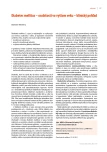Early screening and treatment slow the progression of diabetic nephropathy
Authors:
Peter Ponťuch
Authors‘ workplace:
IV. interná klinika LF UK a UN Bratislava, Nemocnica sv. Cyrila a Metoda, prednosta prof. MUDr. Peter Ponťuch, CSc.
Published in:
Forum Diab 2015; 4(3): 166-169
Category:
Main Theme: Review
Overview
Increasing number of diabetic patients and their longer life expectancy contribute to the higher prevalence of diabetic nephropathy. Epidemiological survey NEFRITI brought actual data on a prevalence of chronic kidney disease in diabetic patients in Slovakia. Early diagnosis based on albuminuria and estimated glomerular filtration rate and subsequent standard treatment are cardinal preconditions for slowing the progression of diabetic nephropathy. Diabetic patients with chronic kidney disease are the biggest subgroup from among all patients on renal replacement therapy. The European Renal Best Practice work group developed Clinical practice guideline on management of patients with diabetes and chronic kidney disease stage 3b or higher.
Keywords:
treatment of diabetic patients with chronic kidney disease – prevalence of diabetic nephropathy – screening of diabetic nephropathy
Sources
1. EURODIAB IDDM Complications Study Group. Microvascular and acute complications in IDDM patients. Diabetologia 1994; 37(3): 278–285.
2. de Boer IH, Rue TC, Cleary PA et al. Long-term renal outcomes of patients with type 1 diabetes mellitus and microalbuminuria: An analysis of Diabetes Control and Complications Trial / Epidemiology of Diabetes Interventions and Complications Cohort. Arch Intern Med 2011; 171(5): 412–420.
3. Ponťuch P, Hozlárová M et al. Za skupinu DIANEBA. Prevalencia diabetickej nefropatie u diabetikov 1. typu v Bratislave. Diabetes a obezita 2002; 2(3): 37–41.
4. Adler AI, Stevens RJ, Manley SE et al. Development and progression of nephropathy in type 2 diabetes: The United Kingdom Prospective Diabetes Study (UKPDS 64). Kidney Int 2003; 63(1): 225–223.
5. Titze S, Schmid M, Köttgen A et al. Disease burden and risk profile in referred patients with moderate chronic kidney disease: composition of the German Chronic Kidney Disease (GCKD) cohort. Nephrol Dial Transplant 2015; 30(3): 441–451.
6. Ponťuch P, Lištiaková D, Černá K et al. Výskyt mikroalbuminúrie, klinickej proteinúrie a artériovej hypertenzie u diabetikov 2. typu na Slovensku. Diabetes a obezita 2004; 4 : 41–48.
7. Martinka E, Ponťuch P. The prevalence of diabetic nephropathy in patients with type 2 diabetes mellitus in Slovakia. The NEFRITI Study. In: 51st meeting of European Association for the Study of Diabetes. Stockholm 2015: A1117. Dostupné z WWW: <http://www.easdvirtualmeeting.org>.
8. Kainz A, Hronsky M, Stel VS et al. Prediction of prevalence of chronic kidney disease in diabetic patients in countries of the European Union up to 2025. Nephrol Dial Transplant 2015; 30(S4): iv113-iv118.
9. KDIGO CKD work group. KDIGO 2012 clinical practice guideline for the evaluation and management of chronic kidney disease. Kidney Int Suppl 2013; 3(1): 1–150.
10. American Diabetes Association. Standards of medical care in diabetes – 2015. Diabetes Care 2015; 38(Suppl 1): S58-S66.
11. European Renal Best Practice. Clinical practice guidelines on management of patients with diabetes and chronic kidney disease stage 3b or higher (eGFR<45 ml/min). Nephrol Dial Transplant 2015; 30(Suppl 2): ii1–142. Dostupné z DOI: <http://dx,doi.org/10.1093/ndt/gfv100>.
Labels
Diabetology Endocrinology Internal medicineArticle was published in
Forum Diabetologicum

2015 Issue 3
Most read in this issue
- A view on the cardiorenal syndrome
- The most frequent infectious complications in diabetic patients and their treatment
- Incidence of diabetic nephropathy in a population of patients with diabetes mellitus in Slovakia: results of the NEFRITI investigation
- Early screening and treatment slow the progression of diabetic nephropathy
